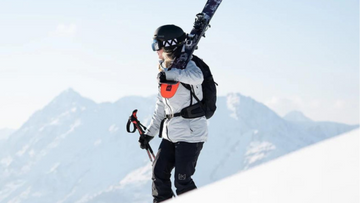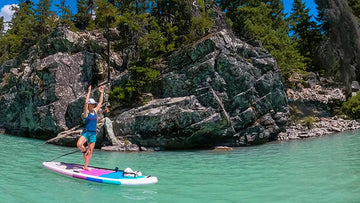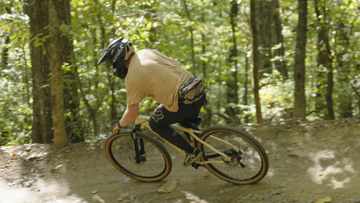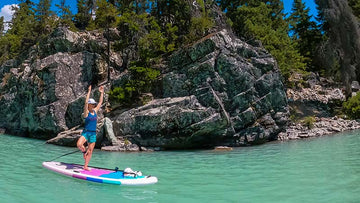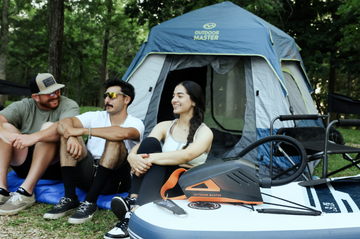
When it comes to paddle boarding, there are two main types of enthusiasts: those who prefer ocean paddle boarding and those who prefer lake or river paddle boarding.
Both have their own unique set of pros and cons, which this article will outline. So, if you're undecided on which one to try first, or if you're just curious about the differences, read on!
Table of content
Ocean vs. Lake vs. River Paddleboarding My Recommended SUP Boards for The Ocean My Recommended SUP Boards for Lakes My Recommended SUP Boards for Rivers How to Paddle Board in the Ocean How to Paddle Board on Lakes How to Paddle Board in Rivers FAQOcean vs. Lake vs. River Paddleboarding
OCEAN PROS:
-
The ocean is a beautiful place to paddle board and there are often turtles, and other wildlife to spot.
-
Ocean waves can provide a nice challenge for more experienced paddleboarders.
-
Salt water is more buoyant than fresh water, so you may find it easier to float on the ocean.
OCEAN CONS:
-
The ocean can be treacherous, with strong currents and dangerous wildlife. It's important to be aware of your surroundings and know your limits.
-
Paddleboarding in the ocean can require a wet suit, as the water is usually cold.
-
There may be more debris in the ocean than in a lake, so you'll need to be careful of what you're paddling over.
LAKE PROS:
-
Lakes are typically much calmer and more predictable than oceans, so they're perfect for beginners or those who want a more relaxed paddle boarding experience.
-
You don't need a wet suit in most cases, as the water can be pretty warm.
-
There's often less debris in lakes than in oceans.
LAKE CONS:
-
Lakes can get pretty crowded during peak times, especially when they are small, so you may have to share the water with a lot of other people.
-
There aren't typically any waves in lakes, so experienced paddle boarders may get bored.
-
Some lakes may have algae or other aquatic plants that can make paddling difficult.
RIVER PROS:
-
Rivers can offer a nice middle ground between lakes and oceans. They may have some waves, but they're usually not as big or strong as ocean waves.
-
You don't need a wet suit in most cases, as the water can be pretty warm.
-
Rivers calm sections offer an ideal place for beginners
RIVER CONS:
-
Rivers can have strong currents, which can be dangerous for paddleboarding.
-
There may be obstacles in the river, like rocks or logs, that you need to avoid.
So, which is better? Ocean, lake, or river paddle boarding? Ultimately, it depends on what you're looking for in a paddle boarding experience. If you want something more challenging, then ocean or fast-moving river paddle boarding is probably for you.
But if you're a beginner or just want a relaxing day on the water, stick to lakes and calm rivers. Whichever you choose, make sure to have fun and stay safe!
My Recommended SUP Boards for The Ocean
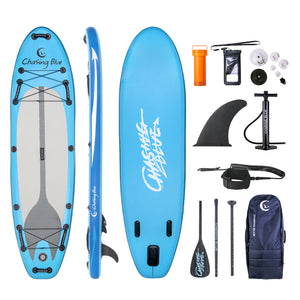
OCEAN SPIRIT - ALL ROUND iSUP BOARD
10'6" FOR ALL-LEVEL
Shop NowUSE CODE: OMBLOG20 FOR 10% OFF
When choosing a paddle board for ocean use, it's important to consider many things including its size and shape. You'll want something that's relatively wide and stable, as ocean waves can be unpredictable and choppy. You don't want to be on a narrow board that's easily toppled by a wave.
The thickness and construction of the board are also important. Usually, thicker boards are more buoyant and feel more stable, but they are also heavier to carry.
Since the ocean can have some chop, if you are not sure of your stability abilities, it will be better for you to go with board construction that flexes a little.
As for shape, if you want to cover distances, choose a SUP board that has a pointed nose that can glide on top of the water with less effort.
My Recommended SUP Boards for Lakes
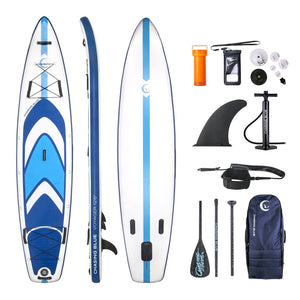
ORION - TOURING iSUP BOARD
12'6" With Double Layer Material
Shop NowUSE CODE: OMBLOG20 FOR 10% OFF
For lake use, you have a little more leeway in terms of board size and shape. You can go for a narrower and lighter board if you want, as there won't be any waves to contend with.
If you want to do some fitness moves or other exercises on your paddle board, look for a board that is very wide and has a flat surface.
Some boards even have fitness mats or other accessories attached to them, which can make your workout more enjoyable.
If you are not sure yet about what you want from paddleboarding or you want something that can suit a little bit of everything, go with an all-around paddle board.
My Recommended SUPp Boards for Rivers

AQUA SPIRIT - ALL ROUND iSUP BOARD
10'6" FOR ALL-LEVEL
Shop NowUSE CODE: OMBLOG20 FOR 10% OFF
For river paddleboarding, you'll want a board that is lightweight and easy to maneuver. You'll also want something that has a bit of extra width for stability, as rivers can have strong currents.
If you are new to paddleboarding, it's best to avoid rivers with strong currents or rapids. Look for calmer sections of the river where you can paddle with ease.
For whitewater rivers, you'll need a board that is wide and short. These boards are designed to be durable and easy to maneuver in fast-moving water.
How to Paddle Board in the Ocean
While you are still planning for your next trip, the first thing to do is to check the weather forecast to avoid heavy winds or storms.
For gear, if you often feel colder than others, it will be better for you to wear something that makes you feel warmer, attach yourself to the board using a leash, and have a whistle to call for help when an emergency arises.
Now that the weather is safer and you are well equipped, launch your paddle board from a point that looks easy for you and lay on top of your board, similar to surfers. If the water is calmer for you, you can walk to the waves until you can't stand anymore.
How to Paddle Board on Lakes

When you are planning to paddle board on a lake, the first thing you need to do is again, check the weather forecast and water conditions to avoid tides of big lakes.
You'll also want to make sure you have the proper gear, which in this case, means a life jacket and the leash.
Entering the lake is easier from boat ramps or lake parts similar to it, and safer away from sharp rocks or things that can hurt you if you fall on them.
How to Paddle Board in Rivers

The first is to always consider the river’s current, classification, and weather conditions before heading out.
Also, be aware of your surroundings and the current. It's important to stay close to the shore and not venture out too far. Another key thing to remember is to always wear a life jacket. And lastly, always paddle with a friend.
Be sure to check the water level of the river before you go. If the water is too high, it can create a strong current that can be difficult to paddle against. If the water is too low, there may not be enough depth to paddle through.
The classification of the river will also affect your decision to paddle. Class I rivers are the easiest and most gentle, while class V rivers are the most difficult and dangerous. Choose a river that is appropriate for your skill level.
And finally, always check the weather conditions before heading out. If it's been raining heavily, the river can rise quickly and become more dangerous.
FAQ
HOW TO STAY SAFE WHILE PADDLEBOARDING?
There are a few things you can do to stay safe while paddle boarding:
-
Wear a life jacket
-
Avoid areas with strong currents
-
Know your limits
-
Be aware of your surroundings
-
Paddle with a friend
-
Bring a whistle or other signaling device
To learn more about safety, check these articles:
- Paddle Board Mistakes to Avoid
- SUP Tips and Tricks for Beginners
DO SHARKS ATTACK PADDLE BOARDS?
While there have been a few reports of sharks attacking paddle boards, it's important to remember that these incidents are very rare.
Sharks typically attack large animals, such as dolphins or seals. They mistake paddle boards for these animals from a distance.
To avoid being attacked by a shark, it's important to stay in well-lit areas and to avoid wearing shiny jewelry.
It's also a good idea to paddle with a friend so that you can keep an eye on each other.
If you do see a shark, try to stay calm and paddle to shore as quickly as possible. Do not attempt to fight the shark or splash around in the water.
DOES SALT WATER DAMAGE SUP BOARDS?
Yes, salt water can damage paddle board seams and metal parts.
It can also cause the deck pad to peel off and the paint to fade.
To avoid damage, rinse off your board with fresh water after each use and store it in a cool, dry place.
It's also a good idea to invest in a paddle board cover to protect your board from the elements.
For more information, check out this article: Paddle Board Repair & Maintenance.
IS IT SAFE TO PADDLE BOARD WHEN THE TIDE IS GOING OUT?
It is safe to paddle board when the tide is going out as long as you are aware of the conditions and know how to read the water.
It's important to avoid areas with strong currents or rip tides.
If you do find yourself in a strong current, paddle parallel to the shore until you can paddle out of the current.
CAN YOU PADDLEBOARD IN WAVES?
Yes, you can paddleboard in waves! Paddleboarding in waves is a great way to improve your balance and coordination, as well as to get a full-body workout. However, it is important to be aware of the dangers of waves before you head out into them.
Waves can be dangerous for paddle boarders because they can easily knock you off your board. If you are not careful, you could end up hitting your head on the bottom of the ocean, which could result in serious injury or even death. Waves can also make your paddle board difficult to stay afloat.
Waves can quickly become large and powerful, making it difficult to paddle through them. If you are not an experienced paddleboarder, it is best to avoid waves altogether. However, if you are confident in your abilities, there are a few things you can do to stay safe while paddle boarding in waves.
HOW TO STAY SAFE WHILE PADDLE BOARDING IN WAVES?
First, when you are still beginning in waves, it is better to wear a life jacket that fits well and does not restrict your movements. A life jacket will help keep you afloat if you are knocked off your board.
Second, always paddle with a friend. Paddle boarding is more fun with someone else, and it is also safer. If you are paddling alone, make sure to let someone know where you are going and when you will be back.
Third, avoid paddling in the biggest waves. It is best to start small and work your way up to bigger waves. Paddleboarding in big waves can be very dangerous and should only be attempted by experienced paddle boarders.
Fourth, be aware of your surroundings and always look ahead. Waves can come out of nowhere, so it is important to be prepared. If you see a wave coming, paddle to the side or duck under it.
Finally, never try to ride a wave. Waves are not meant to be ridden and can easily knock you off your board. If you find yourself on a wave, paddle to the side as quickly as possible.
WHAT TIME OF DAY IS BEST FOR PADDLE BOARDING IN THE OCEAN?
The best time to paddle board is at slack tides. Slack tides are the periods of time between the high and low tides. During slack tide, there is no current and the water is calm. This makes it the perfect time to paddle board because you will not have to worry about being pulled out to sea by a strong current.
CAN YOU PADDLE BOARD WHEN IT'S WINDY?
Winds below 10 mph are not much to worry about when paddle boarding. However, once winds are above 15 mph (10-12 mph if you're a beginner), it is safer to stay off the water because it becomes difficult to paddle against the wind and you may start drifting.
That’s all for this article, before saying see you I would like to let you know that you can join our SUP-dedicated Facebook group, where you can meet like-minded people or get support from our team.
Thank you for your time.
See y’all.


